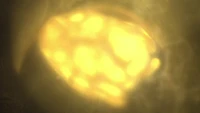| | |
- "There's a meteorite that hit the ground near here. I want to check it out. It won't take long."
- ―Luke Skywalker, to Han Solo

A meteorite was an object that fell onto a planetary surface from space. Commander Luke Skywalker believed that a meteorite crashed near Echo Base on the ice planet Hoth, but in reality it was an Imperial probe droid.[1]
Behind the scenes[]
In real life, a meteorite is a meteoroid (a lump of rock or iron that orbits around the sun)[2] that enters Earth's (or another planet's) atmosphere and hits the ground.[3] The term meteor, on the other hand, refers to the streak of light that appears in the sky when a meteoroid[4] enters the planet's atmosphere but burns up before it reaches the ground, which is why they're also called "shooting stars."[3]
People often confuse meteoroid, meteor and meteorite since they are all used interchangeably in everyday language. The word "meteor" in particular is commonly used for a meteoroid flying through outer space, for a glowing meteoroid in the atmosphere (rather than the burning streak of light in the sky), or for an object that has already landed on Earth (one example is found in the name Meteor Crater, a famous impact-structure in Arizona) or even a human-made object.[5]
Appearances[]
Non-canon appearances[]
 Star Wars: Visions — "Sith" (Mentioned only)
Star Wars: Visions — "Sith" (Mentioned only)
Sources[]
 "Rookies" Episode Guide | The Clone Wars on StarWars.com (backup link)
"Rookies" Episode Guide | The Clone Wars on StarWars.com (backup link) Star Wars Helmet Collection 9 (Highlights of the Saga: Ground Assault on Hoth)
Star Wars Helmet Collection 9 (Highlights of the Saga: Ground Assault on Hoth)- Poe Dameron: Flight Log
- Star Wars: The High Republic: Chronicles of the Jedi
 Bahryn Meteorite in the Databank (backup link)
Bahryn Meteorite in the Databank (backup link)
Notes and references[]
- ↑ 1.0 1.1 Star Wars: Episode V The Empire Strikes Back
- ↑ Meteoroid on National Geographic: "Meteoroids are lumps of rock or iron that orbit the sun, just as planets, asteroids, and comets do." (archived from the original on May 19, 2023)
- ↑ 3.0 3.1 What's the difference between a meteor, meteoroid, and meteorite? on NASA: "Meteoroids are objects in space that range in size from dust grains to small asteroids. Think of them as "space rocks." When meteoroids enter Earth's atmosphere (or that of another planet, like Mars) at high speed and burn up, the fireballs or "shooting stars" are called meteors. When a meteoroid survives a trip through the atmosphere and hits the ground, it's called a meteorite." (archived from the original on April 23, 2023)
- ↑ What's the Difference Between a Meteoroid, a Meteor, and a Meteorite? by Gregersen, Erik on Encyclopedia Britannica: "A meteor is the streak of light that you see in the sky when a small piece of cometary or asteroidal material enters the atmosphere at high speed and burns up because of the frictional heating from the piece's collision with the atoms and molecules in the atmosphere. Before the small bit of comet or asteroid enters Earth's atmosphere, it floats through interplanetary space and is called a meteoroid." (archived from the original on May 23, 2023)
- ↑ meteor and meteoroid on Encyclopedia Britannica: "Meteoroids are believed to be mostly fragments of asteroids and comets and are placed, with them, in the category of solar system objects known as small bodies. A few meteoroids also have come from the Moon, Mars, Vesta, and possibly Mercury. The smallest meteoroids, those less than a few hundred micrometres across (about the size of a period on a printed page), are called interplanetary dust particles or micrometeoroids. The terms meteoroid and meteor (and meteorite as well) are sometimes confusingly interchanged in common usage. Meteor in particular is often applied to a meteoroid hurtling through space, to an incandescent meteoroid (rather than just its luminous streak) in the atmosphere, or to an object that has hit the ground or a human-made object. An example of the last case is found in the name Meteor Crater, a well-known impact structure in Arizona, U.S." (archived from the original on March 7, 2023)
